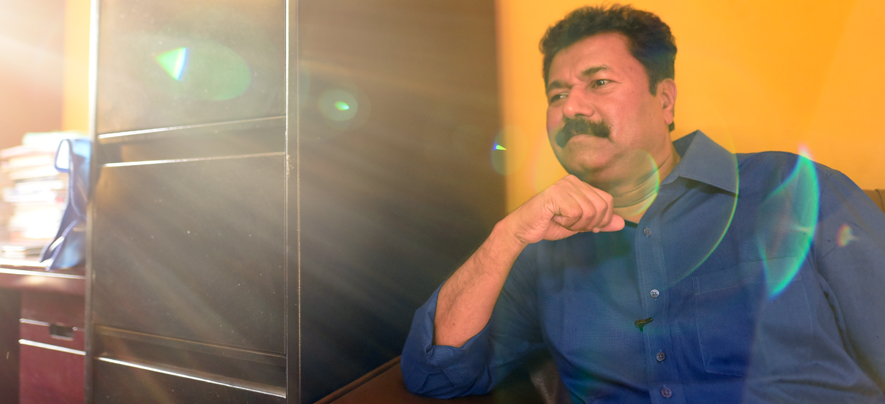Pradeep Lokhande: The tireless crusader who believes in the potential & value of rural India
SME Inspirations
470 week ago — 9 min read
Pradeep Lokhande is a dynamic & visionary social entrepreneur who believes that the real India lives in its villages. For the past 20 years his organisation, rural relations, is working tirelessly to gather vital data about the people who reside in our villages. This data is used to bring about social change and is also leveraged to large corporations for them to better understand their rural market.
Rural relations’ activities span across 49,000 villages in 10 states including Maharashtra, Gujarat, Madhya Pradesh, Rajasthan and Uttar Pradesh. One of the foremost social initiatives launched by rural relations is the Gyan-key project, which establishes libraries in Indian villages, aiming at encouraging and motivating children in the villages to develop reading habits.
Apart from building a databank of key information of each village, rural relations has launched several other social initiatives. These include the ‘Non-Resident Villager' movement – an effort to encourage Indians to give back to their roots and ‘villagewiKY’ – a novel concept that makes data about Indian villages easily accessible.
An indicator of the popularity of Pradeep ji and his initiative is that he receives thousands of postcards from the interiors of India every day. Interestingly, these postcards are addressed to him just by name and his pin code and they unerringly find their way to him.
In conversation with GlobalLinker (GL), Pradeep Lokhande (PL) shares his mission to work for the development of Indian villages. Watch this video to get a glimpse of his keen insight and understanding of India, its villages, its people and their struggles.
GL: Tell us about rural relations.
PL: Rural relations is not an NGO, it’s a professional organisation. I’m in this business for the last 20 years. In India we have 6 lakh villages, 6000 blocks and only 600 districts. We know about the activities at the block level but what about the remote 6 lakh villages?
It’s a huge number, so we developed a unique concept. We realised that there is no need to go to each and every village of the country to collect data. Instead, we must go only to villages that have population of 2000 and above and where weekly bazaars take place. These are just 13% villages of the country, which is a comparatively achievable number of around 85,000 villages. If you are strong in terms of products & services and communication services, you can reach to all 6 lakh villages because people from these smaller villages come to these 85,000 villages to buy their necessities.
We started with Maharashtra that has 43,000 villages, only 375 blocks and 36 districts. So out of these 43,000 villages we selected 6900 villages where weekly bazaars take place and we started collecting basic data. That data includes details like name of the village, district, population, bazaar day gathering, school principal, school master, how many television sets that village has and the availability of the mass consumable things. With this data one can do a great deal social or commercial activity effectively in the village.
We sell this data to large corporations and we use it to bring about social change in rural India. In this organisation we have three major principles. We don’t sell anything because we are relationship-based organisation; we don’t take liquor and tobacco based products to the villages and we don’t work with the government. We understand the language of corporates and we understand the people. We are bridge between both of them. We are basically a facilitator and a catalyst.
GL: What is the scope of rural relations in India?
PL: We have a presence in ten states of the country and have the data of 49,000 villages. These 49,000 villages cater to the need of 3 lakh villages and 50% population of the country.
So we have a relationship with the big brands of the country who have a presence in rural India, either we have worked with them or working with them with our principles. Whatever activity we do, there’s some social aspect in it.
GL: What are some of the activities of rural relations?
PL: In 2001 I made the decision that I will give 40% of my time to business, 40% to social activity and 20% to teaching.
In 2001 we launched one concept called 'Non-Resident Villager' (NRV) movement, practically every Indian is NRV, and has a root in some village or the other. If with this awareness, each person contributes to their native village, India will be a changed country.
Moreover, we have appealed to people in cities to contribute their second-hand computers. I have been instrumental in installing more than 28,000 computers in 20,000 schools in 7 states of the country. This is not a success story; the success story is that more than 70% of the schools have bought new computers once they have been exposed to this fantastic gadget. This is how India is changing in a big way.
Another concept we launched in 2010 was the ‘Gyan-key’ initiative. The premise was that if we want to change India we need to approach and foster the youth who are the future of the nation. Through ‘Gyan-key’ we opened libraries for senior secondary students to promote the habit of reading. In last 1000 days we have opened more than 3000 libraries, every working day we open three libraries. Till date we have reached out to 8.5 lakh villages of the country. The success of this initiative can be gauged by the fact that more than 13,000 students have written back to us their analysis of the books they have read.
Just 229 days back we have launched another concept and probably that concept will help crores of youth of this country to take their businesses to rural India. The name of that concept is villagewiKY. We have taken the Wikipedia base and now you can gain information by demography, ecography, sociography, professionals and institutes of the villages. Every day we are putting 85 villages on the site and it is an open information source. In the next 1000 working days we will have information of 85,000 villages of the country. These 85,000 villages cater to 6 lakh villagers of the country. You will get the entire information of each village on your fingertips. So it’s a very ambitious and game changing project that we have undertaken.
GL: What are some of your learnings?
PL: If you want to be a successful CEO or entrepreneur, unless and until you understand the pulse of rural India, you will not be successful in this country. This is because even today, 55% of our people reside in villages.
You take any segment -- the market share of rural India is more than urban India. We have to look towards rural India for big opportunities.
We are playing the important role of bridging urban India with rural India. Whenever we do an activity in rural India we take the help of rural youth, we call him a village developer.
We believe that the youth of the village will work for the village, and the idea we are trying to communicate is that if you are earning INR 10,000-15,000 in your village, it is as good as earning INR 35,000-40,000 in urban India. So better stay in your village, we will give you the work, because you cannot reach the corporates and vice versa.
So we are playing the role of a catalyst, and we will not take a single rupee from you. Whatever charges we take, we take from the corporate. We have given opportunities to more than 67,000 youths till date to work for professionals and multinational companies.
There are five important things that I have observed in rural India. The first change is that by 2017, practically every Indian will have Android phone and everybody will be connected to the world irrespective of caste and religion. Second, the entire youth of this country is inspired, because of exposure & availability of lot of platforms like GlobalLinker. People are increasingly thinking a lot about doing business and becoming entrepreneurs.
The third change is that girls are getting education and they are going to change two houses, because wherever there is an educated woman, the family prospers.
Fourth, whatever you studying, you must be confident enough that it will be helpful after 5 years. Ask questions from your leaders and similarly in business think about what will be the fate of that business in 5 years.
Lastly, the world is changing at a rapid pace. I believe that by 2032 practically every Indian will proudly declare, “I’m living in a great country.”
Disclaimer: This article is based solely on the inputs shared by the featured member. GlobalLinker does not necessarily endorse the views, opinions & facts stated by the member.
Posted by
GlobalLinker StaffWe are a team of experienced industry professionals committed to sharing our knowledge and skills with small & medium enterprises.
Network with SMEs mentioned in this article
View GlobalLinker 's profile
Most read this week











Comments
Share this content
Please login or Register to join the discussion